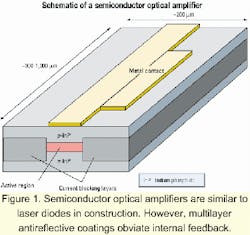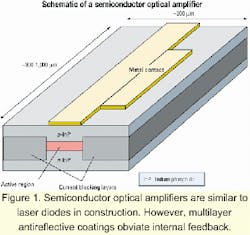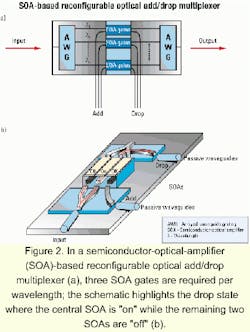Role of semiconductor optical amplifiers in advanced networking
Because of their versatility, SOAs may soon appear in a wide variety of applications.
TONY KELLY and IVAN ANDONOVIC, Kamelian Ltd.
WDM optical networking has evolved rapidly from being simply a more efficient way of increasing throughput to a platform for implementing other photonic functions such as add/drop and switching directly in the optical domain. It is also becoming evident that the mass deployment of these advanced photonic techniques relies on developing routes to the integration of passive waveguiding technologies with active semiconductor devices.
A platform technology is required that will address the need to manufacture advanced components in a scalable way and meet the volume and cost demands of systems integrators. One approach integrates customized (mode-matched) semiconductor optical amplifiers (SOAs) on a silicon microbench with passive components to realize hybrid modules. The advanced functionalities enabled by SOAs range from linear optical amplifiers to on/off switch gates through to all-optical wavelength converters and regenerators.
An SOA is a laser diode operating below threshold. The major difference between SOAs and typical laser diodes is that the SOA's facets have multilayer antireflection coatings to prevent internal feedback. These devices are referred to as traveling-wave amplifiers (TWAs), since signals traverse through the cavity only once and emerge intensified at the output (see Figure 1).
As is the case with semiconductor lasers, one can select the gain peak within a large wavelength range (0.6-1.6 microns) that covers the wavelengths commonly used in telecommunications networks. This versatile component can be used in several modes, including inline linear optical amplification, high-extinction optical on/off gates with inherent gain, and all-optical wavelength converters and regenerators.Optical gain in SOAs is provided by net stimulated emission through the population inversion of the active region created by the application of current across the p-n junction. This stimulated emission is always accompanied by spontaneous emission, where photons of random phase and polarization are added to the signal.
The SOA small signal gain is governed by the material gain, internal loss, device length, and confinement factor. In practice however, the maximum achievable gain is limited by the self-saturation due to spontaneous emission. The spontaneous emission is amplified as it travels along the cavity, resulting in a lowered carrier density and therefore reduced gain.Internal SOA gains can be as high as 40 dB, but the coupling loss per facet is 1-4 dB, yielding typical gains of 25 to 35 dB. The 3-dB gain bandwidth is usually about 45 nm, but structures based on multiquantum wells (MQWs) can exhibit bandwidths of up to 80 nm. Saturation output powers greater than 10 dBm can be achieved.
The dominant noise generated by the SOA is spontaneous emission. The addition of spontaneous noise adds two beat-noise terms at the square law detector. Signal-spontaneous beat noise is generated due to mixing of the signal and the amplified spontaneous emission (ASE); spontaneous-spontaneous noise is generated due to mixing of the ASE components.
The noise performance of an optical amplifier is characterized by the noise figure, defined as the amount of degradation in the signal-to-noise ratio caused by the amplification process. In practice, a narrow optical filter is used before detection, which reduces the level of spontaneous-spontaneous beat-noise. In most practical scenarios, for large gains, signal ASE beat-noise dominates over other sources of noise.
The SOA fundamental lower limit for the noise figure is not substantially different from any phase-insensitive linear amplifier such as an erbium-doped fiber amplifier (EDFA). The major difference when compared to the EDFA is the coupling losses; hence, the effective noise figure rises to between 6 and 10 dB, compared to 4 dB for the EDFA. The fact that SOAs can be integrated with passive planar lightwave components such as arrayed waveguide gratings, splitters, and combiners, however, allows the losses prior to the SOA to be reduced compared to fiber-based amplification. That can result in lower overall subsystem noise figures.Figure 3: Semiconductor optical amplifiers can be used to construct all-optical wavelength converters based on cross-gain modulation. The stronger signal on λ1 modulates the gain of the amplifier, and this modulation is imposed on λ2.
In any optical communication system, the state of polarization at any inline component is unknown, simply because the most widely installed type of optical fiber does not preserve the state of polarization. Thus, apart from a few specialized applications, the SOA has to be polarization-insensitive. There are several ways in which that can be achieved-either through symmetrical waveguide-design, tensile strain to balance the differing confinement factors, or through polarization-insensitive MQW designs. Very low polarization sensitivity (<0.2 dB) can be achieved.
For effective use of SOAs in optical networking, the device input and output has to be coupled efficiently into a singlemode optical fiber. That can be achieved using lensed fiber or by bulk micro-optics to focus the optical field into a fiber. Since in a normal device the waveguide mode is very tightly confined, and therefore highly divergent, positional alignment with submicron tolerances is required to achieve low coupling loss at a considerable expense overhead.
The positional tolerance for packaging can be increased by expanding the output mode of the SOA, most readily achieved through lateral or vertical tapering of the active region. The goal is to expand the mode so that the far field is as symmetric as possible and a close match to that of a singlemode optical fiber. Given that most of the production cost of optoelectronic devices is incurred in the packaging, that is a very important consideration. Indeed, the alignment tolerances can be reduced to the point where passive alignment can be used along with silicon motherboard techniques and precision cleaving.
Furthermore, it is also becoming evident that the mass deployment of advanced photonic functionalities relies on developing routes to the integration of passive waveguiding functionality with active semiconductor devices. For the hybrid technology platform to be a viable proposition, mode-expanded SOAs are crucial.
The use of the SOA as an inline amplifier has received renewed impetus due to the penetration of optical networking into the metro (and potentially access layers), and the concomitant search for a low-cost solution to providing loss compensation across the whole wavelength range now offered by water-free fibers exhibiting low loss from 1,300 to 1,600 nm (see Table 1).
In the case of single-wavelength channel operation, 10-Gbit/sec transmission over 420 km using one preamplifier and 10 inline SOAs has been achieved. The use of an SOA as a receiver preamplifier is an elegant approach to optical preamplification, since the SOA can be integrated with the photodetector to greatly reduce the form factor in comparison to EDFA-based preamplifiers.
Another module that becomes feasible with the use of SOA arrays is a compact channel equalizer. Conventional approaches use a cascade of multiplexers and demultiplexers (input and output) and a means of inducing a controlled attenuation operating on each channel, such as a Mach-Zehnder interferometer. An SOA solution adopts a similar geometry, but now the individual wavelength channels are equalized through adjustment of the gain by control of the bias current.SOAs can also be utilized in WDM transmission when used in the linear regime or by the addition of a "reservoir" continuous-wave channel that serves to reduce the interactions between channels. Impressive demonstrations of 32x10-Gbit/sec and 8x40-Gbit/sec transmission over 160 km using SOAs clearly show their applicability for high-capacity transmission in the metropolitan environment.
Therefore a compact, cost-effective optical amplifier amenable to mass production and integration with other passive distribution platforms is attractive for cost-sensitive metro use. The SOA is well placed for such a role.
To overcome the electronic bottleneck in switching and routing, optical node implementations are attracting a great deal of interest. Large switching matrices comprising SOA gates have traditionally been considered since the gain would reduce insertion losses.
The promise of zero insertion loss and high extinction ratio with the additional benefits of a compact design prompted the development of substantial (16x16) switch sizes. Yet, the buildup of ASE restricted the extent of the matrix, given that any one connection encountered a large number of SOA gates. However, the application of SOA gates can nevertheless be very advantageous, especially if the switching action operates on single-wavelength channels.
Future subsystems need to provide operators in core and metro applications with scalable and flexible networks able to quickly provision services to customers. One of the key functionalities in this evolution is the reconfigurable optical add/drop multiplexer (ROADM). ROADMs extract one or more wavelengths from a fiber (drop function) and re-insert different signals on the same wavelengths (add). Each of the wavelengths in the multiplex can be reconfigured rapidly to pass data through, drop it locally, and add local data at the wavelength being dropped.A SOA-based ROADM design draws on two basic components; passive waveguides to distribute and (de)multiplex signals while the SOA gates perform the switching function by variation of the drive current. This module can also be realized in a hybrid format through the integration of passive-waveguide technology with active SOAs on a single motherboard (Figure 2). The SOA ROADM offers excellent performance, arising predominately from the SOA characteristics (Table 2).
The ROADM characteristics summarized in Table 2 are based on an analysis that assumes preamplification before the module through an EDFA with 30-dB gain and a noise figure of 4.5 dB. The demultiplexer and multiplexer are assumed to introduce 6-dB loss on each channel with an additional 3-dB loss per power splitter, required to distribute the signals to the SOA gating array. The SOAs have a gain of 20 dB with a noise figure of 8 dB.
Due to the interplay of gain and loss and the manner in which noise figures cascade, the noise of the subsystem for through and drop functionality is governed primarily by the input EDFA noise figure. The add channel noise performance is governed by the SOA. In comparison to an entirely passive system with amplification at the subsystem input and output (through an additional EDFA), the noise performance is superior due to the large loss before the output amplifier.
Furthermore, since each wavelength channel is amplified by individual SOAs, not only is the interchannel crosstalk minimized, the level of amplification and output power per channel stays constant with the number of wavelengths. The most important characteristic, however, is the degree of isolation between the dropped and locally added channels. Since that will cause heterodyne crosstalk, a very high value is required for this parameter for satisfactory performance. SOA gates offer extinction ratios in excess of 50 dB.
The SOA-based ROADM also offers the following advantages, a combination which makes it an attractive implementation:
- Simultaneous drop and continued functionality enabling broadcasting.
- Dynamic signal-level control via feedback to set individual SOA output powers, allowing individual wavelength channel equalization.
- Scalable, compact design.
All-optical wavelength converters (AOWCs) allow more efficient use of the wavelength resource while affording a substantial increase in reconfigurability. They convert from one wavelength to another, selected out of a range of wavelengths directly in the optical domain. They provide flexibility and enable the realization of new optical-switching architectures.
Currently, first-generation optical-crossconnect designs implement wavelength conversion and/or regeneration by optoelectronic transponders, a technique that compromises transparency and increases costs. New approaches to wavelength conversion have been developed that circumvent these restrictions, operating directly in the optical domain using the SOA as the enabling element.
SOA gain modulation, when more than one signal is present in the gain medium, is the most straightforward AOWC implementation. If a strong data signal is input to an SOA on λ1 together with a weaker probe on λ2, the strong signal modulates the gain of the amplifier and this modulation is imposed on the probe (Figure 3). The strong signal is then filtered out, while the probe signal is amplified. Wavelength conversion of 100-Gbit/sec data via cross-gain modulation has been demonstrated.
Alternatively, cross-phase modulation (XPM) can be used to perform wavelength conversion. XPM is based on the refractive-index change that accompanies the intensity-induced gain modulation due to the carrier-density-dependent refractive index. This phase modulation is then converted into an intensity change by incorporating the SOA in a structure such as a Mach-Zehnder or Michelson interferometer. Wavelength conversion at 100 Gbits/sec has been demonstrated with XPM.
The XPM geometry is inherently more complicated with respect to fabrication, since integration with passive waveguiding is required. The instability inherent in fiber-based SOA interferometers is caused by the relative path-length fluctuation between the two arms of the interferometer. In integrated devices, however, the path length can be made sufficiently small so that the drift in relative path lengths is obviated.
The integration of the SOAs and waveguides can be achieved using a wide variety of fabrication techniques. The advantage of these integrated devices is the small physical size and the possibility of integration of other components such as distributed-feedback (DFB) lasers for provision of the destination wavelength. Monolithic integration using current technology suffers from poor yield, whereas adopting a hybrid strategy where the waveguides are realized through passive materials such as silica with the active regions optimized in indium phosphide reduces cost while still remaining amenable to mass production.
From a network performance perspective, devices based on XPM have the better characteristics since they are 2R regenerative, the chirp can be tailored, and the device can operate in inverting and non-inverting data output modes. The technologies needed for regeneration and XPM wavelength conversion in the optical domain are in many ways common. Using the wavelength conversion as a building block, 2R and 3R all-optical regeneration modules can be implemented when the conversion is chosen to be to the same wavelength. The cascadability of such devices when combined with clock recovery has effectively been shown to be infinite in recirculating loop experiments.
Optical-fiber amplifiers play a vital role in optical transport applications as power boosters, inline amplifiers, or detector preamplifiers. With the potential deployment of advanced optical-networking concepts in core, metro, and ultimately access applications, a cost-effective solution to implementing optical amplification has highlighted SOAs as a clear alternative.
This versatile device will also form the basis of a range of higher-functionality products. SOAs as gates, all-optical wavelength converters, and regenerators represent a suite of components with wide applications in a number of optical-networking evolution scenarios.
Tony Kelly is vice president, device design, and Ivan Andonovic is chief technical officer at Kamelian Ltd. (Glasgow, Scotland).





